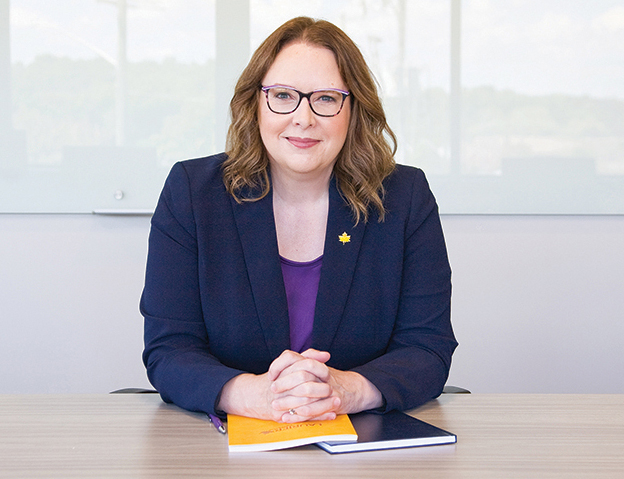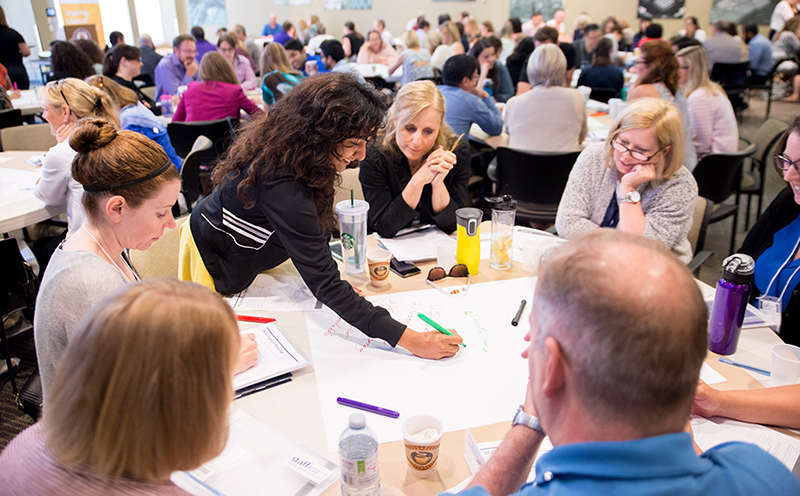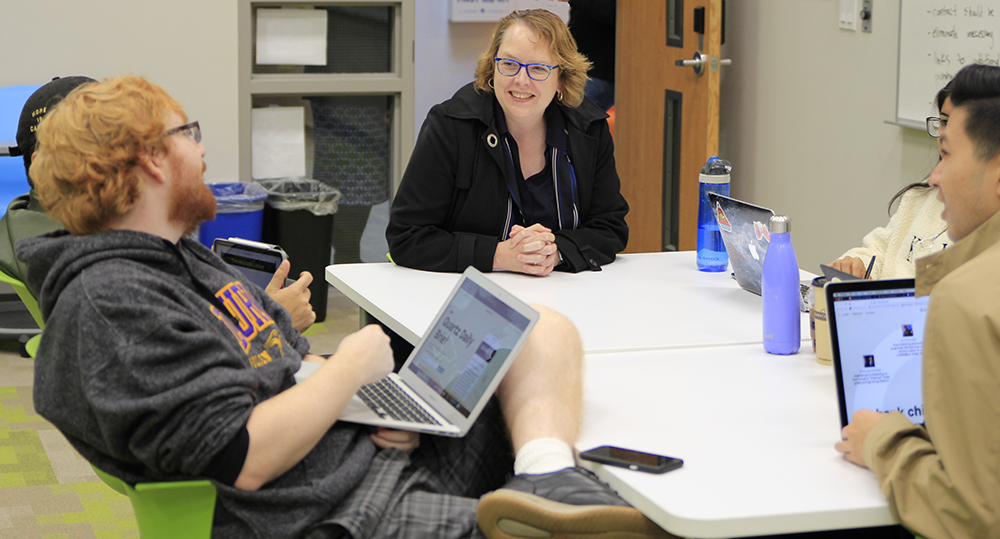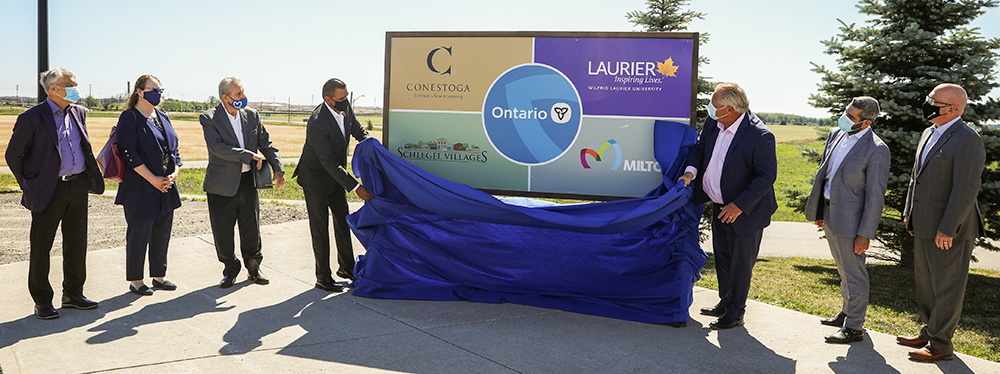Laurier President and Vice-Chancellor Deborah MacLatchy vividly remembers the weeks leading up to the Government of Ontario’s declaration of a public health emergency due to COVID-19 in early 2020.
As news reports came in from around the world of a novel coronavirus sickening people and overwhelming hospitals, MacLatchy consulted her leadership team, the university’s recently assembled Coronavirus Working Group (now the Pandemic Recovery Steering Group), leaders at other post-secondary institutions, and public health officials before making major decisions that would impact Laurier’s more than 22,000 students and 2,000 staff and faculty.

Laurier President and Vice-Chancellor Deborah MacLatchy was recently appointed to a second five-year term that will run from 2022 to 2027.
During early March 2020, Canadian universities monitored the situation south of the border when at least a dozen U.S. universities and colleges moved classes online to mitigate the spread of COVID-19. At Laurier, the president’s office and departments across the university were fielding phone calls and emails from faculty, staff, students and parents asking about the university’s contingency plans.
“At the time, it seemed like a really difficult decision, but in hindsight it was the only decision to make,” MacLatchy says of the move to discontinue in-person instruction, move thousands of students out of residence and pivot to a virtual work environment for all but essential services staff.
President and Vice-Chancellor Deborah MacLatchy
Now, following the fall 2021 term and a successful gradual and phased return to in-person activities at Laurier, MacLatchy approaches the ever-evolving situation with a combination of flexibility and careful consideration. Each decision is based on expert advice and input, with MacLatchy prioritizing the health and safety of the Laurier community.
An ability to be nimble while remaining steadfast to Laurier’s values has served MacLatchy well through her first five-year term as Laurier’s president and vice-chancellor, enabling the university to pursue and achieve a number of ambitious goals.
“It’s really the quality and engagement of our people – Laurier’s students, full-time faculty, contract-teaching faculty, staff, alumni and donors – who have enabled the university to accomplish so much,” MacLatchy says.
Now, recently appointed to a second five-year term that will run from 2022 to 2027, MacLatchy has set her sights on raising Laurier’s profile even higher and increasing the university’s impact in key priority areas outlined in Laurier Strategy 2019-2024, the university’s strategic plan.
“Our university is well-known for its academic excellence, exceptional student experience and community engagement,” says MacLatchy. “So, the question for me is, how do we continue to evolve to meet the current needs of students, society and our partners? What will continue to strengthen and differentiate us as a university?”
The last half decade has been a time of significant change at Canadian universities, a time that intersected with MacLatchy stepping into the role of president. Today, university presidents are tasked with leading institutions that support growing student bodies with a diversity of interests and needs, from local students fresh out of high school to international students and mid-career learners.
At the same time, communities and businesses have turned to universities to support the education, upskilling and reskilling of individuals facing a rapidly changing world of work.

Laurier staff members work to provide input into Laurier Strategy:2019-2024 during a past staff development day event.
There is also an increased need for the innovation faculty and researchers bring to the table as societies seek their expertise to address global challenges including pandemic recovery, climate change, poverty and conflict.
To ensure Laurier was focusing its efforts on meeting these increasingly complex demands, MacLatchy led a strategic planning process during the fall of 2018 and winter of 2019 to create a five-year plan that would guide Laurier’s future. Staff, full-time and part-time faculty, students and alumni shared their aspirations for Laurier through surveys, group discussions and meetings. Post-secondary sector data were analyzed by a steering committee comprising 28 members from all areas of the university. With this information, the steering committee developed Laurier Strategy 2019-2024, which has two guiding themes: thriving community and future readiness.
“We are a people-centred organization. To be able to support our students, faculty, staff and alumni we need to be forward looking to address their evolving needs,” says MacLatchy, reflecting on the Laurier Strategy and its guiding themes. “We know there are things that we need to do better.”

President and Vice-Chancellor Deborah MacLatchy meets with students in Lazaridis Hall prior to the COVID-19 pandemic.
One area where MacLatchy sees opportunity for Laurier is in accelerating the university’s work in Indigeneity and equity, diversity and inclusion (EDI) to address systemic barriers and meet the needs of this and the next generations of students.
A point that resonated with Laurier’s president during strategic planning consultations was how many people at the university noted Laurier’s exceptional sense of community and a campus environment that fosters strong student engagement.
Alumni shared fond memories of professors who acted as mentors and talked about lifelong friendships that began at Laurier. Current students talked favourably about the small campus feel in both Brantford and Waterloo, while staff and faculty said they felt supported by their colleagues and managers.
By contrast, however, there were some who said they felt excluded from the Laurier community. Those shared experiences and the individuals who shared them during strategic planning consultations stuck with MacLatchy.
“It is evident we need to do more to intentionally build that thriving community at Laurier that embraces inclusion for everyone,” she says.
The brutal and tragic events of the summer of 2020, which galvanized worldwide support for the Black Lives Matter movement, and the discovery of unmarked graves at residential school sites across Canada in 2021, reaffirmed the importance of Indigeneity and EDI work at Laurier.
During 2020, the university created an EDI and Indigeneity action plan to hold the institution accountable for realizing its aspirations. A number of major projects are underway to accelerate work in this area.
President and Vice-Chancellor Deborah MacLatchy
Under the direction of Barrington Walker, associate vice-president: EDI, and Darren Thomas, associate vice-president: Indigenous Initiatives, Laurier is developing strategic plans for both EDI and Indigeneity – distinct from Laurier Strategy 2019-2024 – that will guide the work of the university in these areas.
In May 2021, the university committed to hiring at least 12 new tenured faculty members – six Black scholars and six Indigenous scholars – as an intentional step toward broadening the diversity of scholarship and knowledge at Laurier and creating a faculty that better reflects the student body. Laurier is also one of 17 Canadian universities participating in the federal government’s Dimensions Pilot Program. As part of the program, Laurier is collecting EDI data to identify service gaps and barriers that impact students, faculty and staff.
“It’s been a priority for me that Laurier finds its own path forward in Indigeneity and EDI work and that we do it as best we possibly can for our community,” says MacLatchy. “We will continue to do that in the coming years, because the key to a strong university is creating a community that welcomes all people to share their ideas and builds on each community member’s experiences and passions.”

MacLatchy says welcoming students from around the world is another way Laurier can enhance its thriving community, noting that during the past five years the university has worked to build global partnerships and elevate Laurier on the international stage.
Recently, Heidi Northwood was appointed senior executive officer of global strategy, in addition to her role as senior executive officer of Laurier's Brantford campus. In the role, Northwood is responsible for leading the development of an institutional strategy to guide and support the future of internationalization at the university.
“Having Canadian students and international students side by side in Laurier’s classrooms makes for a really robust learning and cultural experience for everyone,” says MacLatchy.
In March 2021, Laurier partnered with Navitas, a global leader in international student recruitment, to open Wilfrid Laurier International College on the Brantford campus. This bridging program supports international students who want to make the transition to study at Laurier. Following successful completion of the one-year program, students can continue their degree studies in programs on the Brantford or Waterloo campus.
For MacLatchy, Wilfrid Laurier International College is just one part of a multi-pronged approach to realizing Laurier’s international aspirations. She sees Laurier taking a more coordinated approach to global partnerships in research and innovation, as well as international student recruitment.
“We know that many of our faculty have exciting, long-term partnerships with international researchers,” says MacLatchy. “There is so much opportunity to build on that global connectivity for research and to support international student recruitment at both the graduate and undergraduate levels.”
Amid a rapidly changing world of work, many people are looking for ways to access education outside of full-time undergraduate and graduate degree programs. MacLatchy sees Laurier as an institution that can provide these opportunities and prepare individuals for future employment. Under MacLatchy’s leadership, the university is prioritizing expanding the ways people access post-secondary education and training.
“The best universities don’t ignore the trends in society and the economy,” says MacLatchy.

“The best universities don’t ignore the trends in society and the economy,” says Laurier President and Vice-Chancellor Deborah MacLatchy. “There is so much value that Laurier can provide to individuals and communities through shorter bursts of learning.”
“There is so much value that Laurier can provide to individuals and communities through shorter bursts of learning.”
This includes testing new ways of offering education to community members through innovative partnerships with businesses and organizations. One recent example is Laurier’s membership in Communitech’s Future of Work and Learning Coalition in Waterloo. During 2020, the university partnered with Communitech and local businesses to address skills and knowledge gaps in the community. Through a combination of learning modules offered through Communitech Academy and immersive courses taught by Laurier faculty, 40 mid-career workers expanded their knowledge and skills in sales and communication.
In Brantford, the Faculty of Human and Social Sciences and Office of Indigenous Initiatives in January 2021 launched a certificate program for professionals in the legal, social, Indigenous rights and public safety sectors. Gladue Principles: Indigenous Peoples and the Canadian Criminal Justice System covers historical contexts of Indigenous peoples’ relationship with the Canadian criminal justice system, including the generational effects of colonization. There are also opportunities for students to participate in a for-credit course on this topic.
President and Vice-Chancellor Deborah MacLatchy
MacLatchy views these shorter bursts of education as a way for people to “stick their toe in the water” in a field of knowledge. During the coming years, she sees Laurier expanding its continuing education offerings in new ways to provide needed skills training and create increased opportunities for people to access programs.
“There are so many ways to integrate university-level learning with the evolving needs of individuals,” she says. “What’s critical is that we don’t just focus on technical skills. Fostering enduring skills that lead to innovative and creative thinking, collaboration, good judgement and leadership are what universities do best and how we differentiate ourselves among other skills providers.”
Enhancing Laurier’s support for innovation and entrepreneurship is another way MacLatchy sees the university preparing individuals for the future. Over time, Laurier has gained a reputation for developing students who are engaged citizens of their communities – a reputation that is in part thanks to the university’s evolution into a hub for entrepreneurship and innovation.
During the past year, Laurier students have found success on the global stage with innovative ideas. Among them was the creation of Earth Suds, soap and shampoo tablets that eliminate plastic packaging, which earned Laurier students the national winner and runner-up titles at the 2020 and 2021 Enactus World Cup, a prestigious global competition that sees student teams showcase the collective impact of their entrepreneurial and community outreach efforts.
Faculty members across the institution are making significant contributions in their scholarly fields. Researchers are creating and disseminating knowledge addressing society’s most pressing challenges across a range of disciplines, from the liberal arts and sciences to professional programs. MacLatchy is excited about the opportunity for Laurier’s new Strategic Research Plan to support elevation of Laurier’s strengths. These areas include environment and sustainability; psychological and social determinants of health and well-being; governance and policy; Indigeneity, decolonization, equity, diversity and inclusion; business, technology and innovation; and society, culture and community.
As president, MacLatchy takes great pride in the exceptional work of Laurier’s students, staff and faculty. She also looks for ways to enhance connections to that work across the university and with business and government. To meet that goal, MacLatchy recently appointed Jonathan Newman, vice-president: research, to oversee the development of an innovation and entrepreneurship strategy for Laurier.
During the coming years, with a strategic plan in place, MacLatchy sees Laurier taking a more coordinated approach to community engagement and scholarship, as well as supporting companies, organizations and government through faculty and student knowledge and expertise.

One of the brightest moments of MacLatchy’s first term as president came in June 2021 when the Province of Ontario announced the approval of a Laurier campus in Milton. The Milton campus, more than 10 years in the making, represents the next step in Laurier’s strategic multi-campus growth. The campus will offer STEAM (science, technology, engineering, arts and mathematics) programming under a planetary health umbrella. When the campus opens to its first students in 2024, it will offer programs including software engineering, environmental engineering, environmental health sciences and climate change management.
“I am thrilled that we are developing programming that integrates – in a very holistic way – arts with the traditional STEM fields,” says MacLatchy. “Laurier was founded as a liberal arts university and we are well positioned to support the education of computer programmers who have a high degree of ethical judgement and engineers who consider equity and accessibility in all that they do.”
For MacLatchy, a key priority during the next five years will be overseeing the continued growth of each Laurier campus based on its strengths and the community it serves.
“I like to say that Milton is in its start-up phase, Brantford is in its scale-up phase and Waterloo is a mature campus,” she says.
In Brantford, the focus during the next five years will be on developing the One Market building into a mixed-use facility with classrooms, student lounges and businesses, as well as growing the student body to 5,000 in the downtown core.
“To grow Brantford will take government and community partnerships – things we are very good at as a university – in support of our academic mission,” says MacLatchy. “I look forward to our continued conversations to bring science and education programs to Brantford to add to our robust suite of arts and professional programs.”
President and Vice-Chancellor Deborah MacLatchy
A project near to MacLatchy’s heart – the renovation and expansion of the Faculty of Music building – will be a focus in Waterloo during the coming years. MacLatchy notes that she is committed to ensuring all faculty and students have the academic infrastructure they need to thrive.
Growing and developing three different campuses in three different communities is a tall order. But MacLatchy is excited by each of the opportunities and challenges that lay ahead. She says Laurier’s focus on academic excellence and exceptional student experience will continue to underpin all of the university’s initiatives and activities.
“I don’t know what I would do if I was in an organization that was uniform because I get so many great ideas from everyone at Laurier,” says MacLatchy. “I love that we are such a diverse community, with a variety of perspectives on our priorities and how to achieve our mission. There is such passion here. It makes it exciting to get up every day and come to work.”